Generic Pelion Device Management example for various U-blox-based boards.
Dependencies: ublox-at-cellular-interface ublox-cellular-base
DEPRECATED
This example application is not maintained and not recommended. It uses an old version of Mbed OS, Pelion DM, and Arm toolchain. It doesn't work with Mbed Studio.
Please use: https://os.mbed.com/teams/mbed-os-examples/code/mbed-os-example-pelion/
This example is known to work great on the following platforms:
- UBLOX_C030_R412M over Cellular and using SD card.
- UBLOX_C030_U201 over Cellular and using SD card.
For Odin-W2 please go to Repository link
Follow the Quick-Start instructions: https://cloud.mbed.com/quick-start


Example functionality
This example showcases the following device functionality:
- On user button click, increment Pelion LWM2M button resource.
- Allow the user to change the state of the board LED from Pelion LWM2M led_state resource and PUT request.
- (currently disabled)
Read ADC temperature and ADC vref, and report them as Pelion LWM2M resources.
Use this example with Mbed CLI
1. Import the application into your desktop:
mbed import https://os.mbed.com/teams/ublox/code/pelion-example-common cd pelion-example-common
2. Install the CLOUD_SDK_API_KEY
mbed config -G CLOUD_SDK_API_KEY <PELION_DM_API_KEY>
For instructions on how to generate your API key, please see the documentation.
3. Initialize firmware credentials (done once per repository). You can use the following command:
mbed dm init -d "<your company name in Pelion DM>" --model-name "<product model identifier>" -q --force
If above command do not work for your Mbed CLI, please consider upgrading Mbed CLI to version 1.8.x or above.
4. Compile and program:
mbed compile -t <toolchain> -m <TARGET_BOARD>
(supported toolchains : GCC_ARM / ARM / IAR)
main.cpp
- Committer:
- screamer
- Date:
- 2019-02-20
- Revision:
- 6:2fb5057c0e42
- Parent:
- 3:3b2db67b206e
- Child:
- 7:230af466efc4
File content as of revision 6:2fb5057c0e42:
// ----------------------------------------------------------------------------
// Copyright 2016-2018 ARM Ltd.
//
// SPDX-License-Identifier: Apache-2.0
//
// Licensed under the Apache License, Version 2.0 (the "License");
// you may not use this file except in compliance with the License.
// You may obtain a copy of the License at
//
// http://www.apache.org/licenses/LICENSE-2.0
//
// Unless required by applicable law or agreed to in writing, software
// distributed under the License is distributed on an "AS IS" BASIS,
// WITHOUT WARRANTIES OR CONDITIONS OF ANY KIND, either express or implied.
// See the License for the specific language governing permissions and
// limitations under the License.
// ----------------------------------------------------------------------------
#ifndef MBED_TEST_MODE
#include "mbed.h"
#include "simple-mbed-cloud-client.h"
#include "FATFileSystem.h"
#include "LittleFileSystem.h"
// Default network interface object. Don't forget to change the WiFi SSID/password in mbed_app.json if you're using WiFi.
NetworkInterface *net = NetworkInterface::get_default_instance();
// Default block device available on the target board
BlockDevice *bd = BlockDevice::get_default_instance();
#if COMPONENT_SD || COMPONENT_NUSD
// Use FATFileSystem for SD card type blockdevices
FATFileSystem fs("fs", bd);
#else
// Use LittleFileSystem for non-SD block devices to enable wear leveling and other functions
LittleFileSystem fs("fs", bd);
#endif
#if USE_BUTTON == 1
InterruptIn button(BUTTON1);
#endif /* USE_BUTTON */
// Default LED to use for PUT/POST example
DigitalOut led(LED1);
// Declaring pointers for access to Pelion Device Management Client resources outside of main()
MbedCloudClientResource *button_res;
MbedCloudClientResource *led_res;
MbedCloudClientResource *post_res;
// An event queue is a very useful structure to debounce information between contexts (e.g. ISR and normal threads)
// This is great because things such as network operations are illegal in ISR, so updating a resource in a button's fall() function is not allowed
EventQueue eventQueue;
/**
* PUT handler - sets the value of the built-in LED
* @param resource The resource that triggered the callback
* @param newValue Updated value for the resource
*/
void put_callback(MbedCloudClientResource *resource, m2m::String newValue) {
printf("PUT received. New value: %s\n", newValue.c_str());
led = atoi(newValue.c_str());
}
/**
* POST handler - prints the content of the payload
* @param resource The resource that triggered the callback
* @param buffer If a body was passed to the POST function, this contains the data.
* Note that the buffer is deallocated after leaving this function, so copy it if you need it longer.
* @param size Size of the body
*/
void post_callback(MbedCloudClientResource *resource, const uint8_t *buffer, uint16_t size) {
printf("POST received (length %u). Payload: ", size);
for (size_t ix = 0; ix < size; ix++) {
printf("%02x ", buffer[ix]);
}
printf("\n");
}
/**
* Button handler
* This function will be triggered either by a physical button press or by a ticker every 5 seconds (see below)
*/
void button_press() {
int v = button_res->get_value_int() + 1;
button_res->set_value(v);
printf("Button clicked %d times\n", v);
}
/**
* Notification callback handler
* @param resource The resource that triggered the callback
* @param status The delivery status of the notification
*/
void button_callback(MbedCloudClientResource *resource, const NoticationDeliveryStatus status) {
printf("Button notification, status %s (%d)\n", MbedCloudClientResource::delivery_status_to_string(status), status);
}
/**
* Registration callback handler
* @param endpoint Information about the registered endpoint such as the name (so you can find it back in portal)
*/
void registered(const ConnectorClientEndpointInfo *endpoint) {
printf("Registered to Pelion Device Management. Endpoint Name: %s\n", endpoint->internal_endpoint_name.c_str());
}
int main(void) {
printf("\nStarting Simple Pelion Device Management Client example\n");
#if USE_BUTTON == 1
// If the User button is pressed ons start, then format storage.
if (button.read() == MBED_CONF_APP_BUTTON_PRESSED_STATE) {
printf("User button is pushed on start. Formatting the storage...\n");
int storage_status = StorageHelper::format(&fs, bd);
if (storage_status != 0) {
printf("ERROR: Failed to reformat the storage (%d).\n", storage_status);
}
} else {
printf("You can hold the user button during boot to format the storage and change the device identity.\n");
}
#endif /* USE_BUTTON */
// Connect to the Internet (DHCP is expected to be on)
printf("Connecting to the network using the default network interface...\n");
net = NetworkInterface::get_default_instance();
nsapi_error_t net_status = NSAPI_ERROR_NO_CONNECTION;
while ((net_status = net->connect()) != NSAPI_ERROR_OK) {
printf("Unable to connect to network (%d). Retrying...\n", net_status);
}
printf("Connected to the network successfully. IP address: %s\n", net->get_ip_address());
printf("Initializing Pelion Device Management Client...\n");
// SimpleMbedCloudClient handles registering over LwM2M to Pelion Device Management
SimpleMbedCloudClient client(net, bd, &fs);
int client_status = client.init();
if (client_status != 0) {
printf("Pelion Client initialization failed (%d)\n", client_status);
return -1;
}
// Creating resources, which can be written or read from the cloud
button_res = client.create_resource("3200/0/5501", "button_count");
button_res->set_value(0);
button_res->methods(M2MMethod::GET);
button_res->observable(true);
button_res->attach_notification_callback(button_callback);
led_res = client.create_resource("3201/0/5853", "led_state");
led_res->set_value(led.read());
led_res->methods(M2MMethod::GET | M2MMethod::PUT);
led_res->attach_put_callback(put_callback);
post_res = client.create_resource("3300/0/5605", "execute_function");
post_res->methods(M2MMethod::POST);
post_res->attach_post_callback(post_callback);
printf("Initialized Pelion Device Management Client. Registering...\n");
// Callback that fires when registering is complete
client.on_registered(®istered);
// Register with Pelion DM
client.register_and_connect();
#if USE_BUTTON == 1
// The button fires on an interrupt context, but debounces it to the eventqueue, so it's safe to do network operations
button.fall(eventQueue.event(&button_press));
printf("Press the user button to increment the LwM2M resource value...\n");
#else
// The timer fires on an interrupt context, but debounces it to the eventqueue, so it's safe to do network operations
Ticker timer;
timer.attach(eventQueue.event(&button_press), 5.0);
printf("Simulating button press every 5 seconds...\n");
#endif /* USE_BUTTON */
// You can easily run the eventQueue in a separate thread if required
eventQueue.dispatch_forever();
}
#endif /* MBED_TEST_MODE */
 u-blox
u-blox